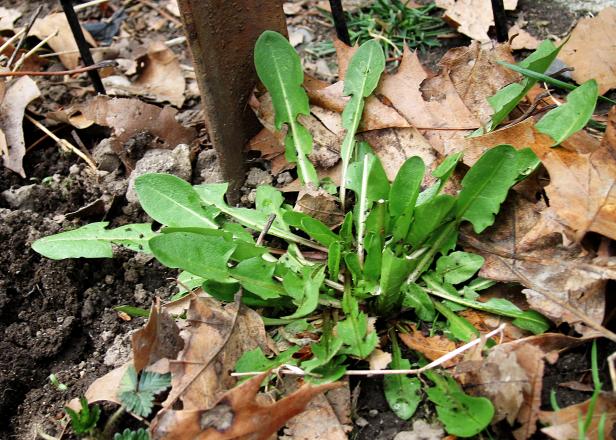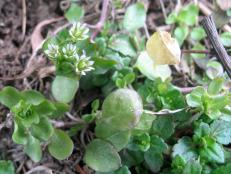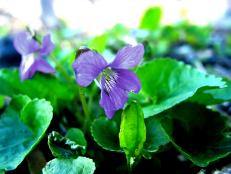Wild Man: A Meddlesome But Toothsome Weed, Dandelion

Foraging expert Steve Brill has shared his foraging wisdom at schools, museums, parks departments, environmental organizations, and with scout troops since 1982. He’s written three books and an app, stars in a DVD and maintains a website at Wild Man Steve Brill.
The Common Dandelion (Taraxicum officinale)
Description
We'll begin with one of the best-known wild edibles and most hated lawn weeds. Everyone recognizes the conspicuous yellow flowers of this European perennial, but getting the youngest leaves when they're tasty, before the flowers appear, takes a bit of attention.
The jagged leaves grow from three to 12 inches long and 0.5 to 2.5 inches wide, always growing in a basal rosette, where the leaves from the base of the plant (this species has only basal leaves) spread out in a circle, like the petals of a rose. The leaves' large jabbed teeth always point toward the leaf base, not outward or toward the leaf tip, like some similar-looking plants.
A cluster of short, stubby, green, flattened, rounded flower buds form in the middle of the basal rosette before the individual, smooth, green, slender flower stalks lift each bud individually two to 18 inches above the ground. The yellow composite flowers, one to two inches wide, consist of ray flowers only (composite flowers often have two types of flowers clustered into a single flower head). Reflexed (bent) green bracts (modified leaves) bend under each flower. The flower heads change into the familiar white spherical seed heads overnight. A tiny white parachute connects to each tiny brown seed, which is shaped like a sunflower seed.
The thick, brittle, beige, branching, perennial taproot grows up to 10 inches long. All parts of this hairless plant exude a white milky sap when broken.
Seasons
The youngest leaves are good to eat in early spring, when they first appear, and in late fall, when new leaves emerge. The crowns and flower buds appear in early spring too, soon after the young leaves. The plants all flower later in early spring, when the flowers are at their best, although some continue to bloom in the summer and fall. The taproot is in season spring, summer and fall—also in winter where winters are very mild and there are enough leaves left to locate it.
Habitat
This European plant grows on lawns, along roadsides, in meadows, cultivated areas and disturbed habitats worldwide.
Harvesting
Collect only the smaller, youngest leaves, when they first come up in early spring and late fall. They become increasingly bitter soon after they appear, especially by the time they flower, and through the rest of the growing season. The bitter leaves aren't harmful; they're just inferior to the youngest ones. Look around before harvesting and choose plants with the broadest leaves, which are the best, not the ones where the majority of the leaves consist mostly of teeth.
While you can certainly grab handfuls of leaves, cutting the root just under the center of the rosette with a pocketknife gets you the entire rosette in an instant, and while it's still intact, you can shake off most of the soil and debris before bagging the plant.
A serrated grapefruit spoon is even better than a pocketknife for cutting and scooping out the very young cluster of flower buds while they're at ground level, in the center of the rosettes.
Collect the flowers by hand, and be sure to choose the most brightly colored ones. These are the freshest, tastiest ones, especially abundant during the peak of the flowering period, toward the end of early spring. Use a knife to remove the bitter green sepals in the field or at home.
As with most roots, a shovel is the second best implement for digging them up. (The first best implement is a kid — kids love digging, and you won't have to lift a finger before you have a bagful of roots!) Since dandelions are so common, you can be picky about where you're going to dig them up. Choose relatively rock-free soil, and dig after periods of rain, when digging is easiest.
Food Preparation
Add the youngest leaves, or their white bases alone, called "crowns," or the flowers (without their bitter green sepals) raw to salads. They're quite tasty, strongly flavored, with an overtone of bitterness. If the slight bitterness bothers you, use them sparingly, or include strong-flavored ingredients such as wild onions (Allium spp.).
Sautéing dandelion leaves or crowns shrinks them and concentrates this bitterness, but this miraculously vanishes if you cook them further in a sauce, especially if you include spices. I sauté them for 10 minutes, then simmer them for another 10 minutes using cooking oil, spices and sauce that hail from the same culinary tradition. You can make a side dish this way, or include pasta, grain, bread cubes or other sources of protein to make a dandelion-based entrée.
You can sauté the flower buds, or after removing the sepals, the flowers too. They taste somewhat like carrots, so sautéing dandelions in olive oil with carrots, seasoning this with mint and marjoram, and adding a dash of white wine plus salt and pepper to taste, works especially well. The carrots' sweetness offsets the flowers' slight bitterness.
You could also stir the flowers into pancake batter and cook this on a griddle like you'd cook pancakes, to make dandelion fritters. The flowers are also famous for making dandelion wine.
Some people cook and eat the taproots. I've found them too bitter and fibrous—way inferior to other wild root vegetables. Conceivably, the youngest taproots might be better, but since the dandelion's a perennial, there's no way to determine in advance which taproots are the youngest.
People have also roasted the taproots until black, ground them and used them for making coffee. As someone who doesn't like coffee, I've never tried it myself. The flavor of coffee complements that of chocolate, however, so you could try using very small amounts of black-roasted dandelion roots, ground in a spice grinder, as a seasoning in chocolate recipes.
Nutrition
The leaves have more beta-carotene, the precursor of vitamin A, than carrots, and more iron and calcium, than spinach. They also provide vitamins B1, B2, B5, B6, B12, C, E, P and D, plus biotin, inositol, potassium, phosphorus, magnesium and zinc. The flowers provide beta carotene too. Oh, and if I didn't already mention it, eating dandelion leaves is good for you!
Medicinal Uses
People have been drinking a decoction of dandelion roots, made by simmering 1 tablespoon of the chopped root in 1 cup of water for 20 minutes, as a tonic since prehistoric times. It contains inulin, a polysaccharide that doesn't elicit an insulin response — good for diabetics and hypoglycemics.
Due to the glycoside taraxacin, it's said to be good for the liver and gallbladder, where it promotes the flow of bile, reduces inflammation of the bile duct and helps get rid of gallstones. It’s also said to be good for chronic hepatitis, where it reduces liver swelling and jaundice, and it helps indigestion caused by insufficient bile.
The decoction is also a diuretic and has been used for centuries for kidney problems and water retention.
Cautions
Dandelion root decoction should be avoided in cases of irritable stomach or bowel, or if there's acute inflammation, but that's not the greatest danger this plant can pose: eating the dandelion that grows just inside Central Park's West 81 St. entrance can be extremely dangerous, as evidenced by what happened in 1986, when I was issued a summons for removing vegetation from the park because I had eaten a dandelion! Charges were eventually dropped, and I was even hired to lead foraging tours throughout the NYC parks system for a time.
Similar Plants
The common dandelion has no poisonous lookalikes. You can use other similar but less widespread Taraxacum species the same way you'd use the common dandelion.
Other edible relatives, all with a white, milky latex, look similar when young, but they're very different when they get older:
Chicory's (Cichorium intybus) young leaves' teeth, which are smaller than dandelions' and are sometimes rounded, don't always point to the leaf bases, and there's often a reddish color on the leaf midrib. When it gets older, it grows a stem several feet tall and bears blue flowers. Dead sticks from the previous year's woody stem persist, arising from the basal rosette, into early spring.
Wild lettuce (Lactuca spp.) is also edible. Its young basal leaves resemble dandelions', but it has more shallow teeth that don't all point toward the leaf base. The leaves have at least some hairs, they're triangular in cross section, and the plant gets much taller than the dandelion. The flowers grow in groups, not individually, and it has fibrous roots, not a taproot.
Sow thistle (Sonchus spp.), also edible and with taller, yellow flowers, has bristly leaves.
Dandelions Thai Style
Simmering dandelion leaves after sautéeing them removes their bitterness and makes them delicious, even more so with traditional Thai ingredients.
- 1/4 cup coconut oil
- 9 cups young common dandelion leaves or other wild vegetables
- 1 clove of garlic, chopped
- 1-1/2 cups coconut milk
- 1-1/2 cups soft tofu, drained and diced
- 1 tablespoon kudzu or arrowroot
- 1-1/2 tablespoons lime juice
- 2 tablespoons basil
- 1 teaspoon powdered ginger
- 1 teaspoon cloves
- 1-1/2 tsp. salt, or to taste
- 1 teaspoon hot sauce, or to taste
1. Sauté the common dandelion leaves, tofu and garlic in the oil 10 minutes.
2. Meanwhile, puree the remaining ingredients in a blender.
3. Add the puree to the dandelions, bring to a boil, over medium heat, stirring constantly, reduce the heat to low, cover and simmer 10 minutes.
Serves 6
Preparation/cooking time: 30 minutes
Editor's Note: The content of this article is provided for general informational purposes only. Be cautioned that some wild plants can be poisonous, and poisonous plants sometimes resemble edible plants which often grow side by side. It is the responsibility of the reader, or the reader’s parent or guardian, to correctly identify and use the edible plants described. HGTV does not guarantee the accuracy of the content provided in this article and is not liable for any injury resulting from use of any information provided.
This article is not intended as medical advice. Always consult a professional healthcare provider before trying any form of therapy or if you have any questions or concerns about a medical condition. The use of natural products can be toxic if misused, and even when suitably used, certain individuals could have adverse reactions.





































